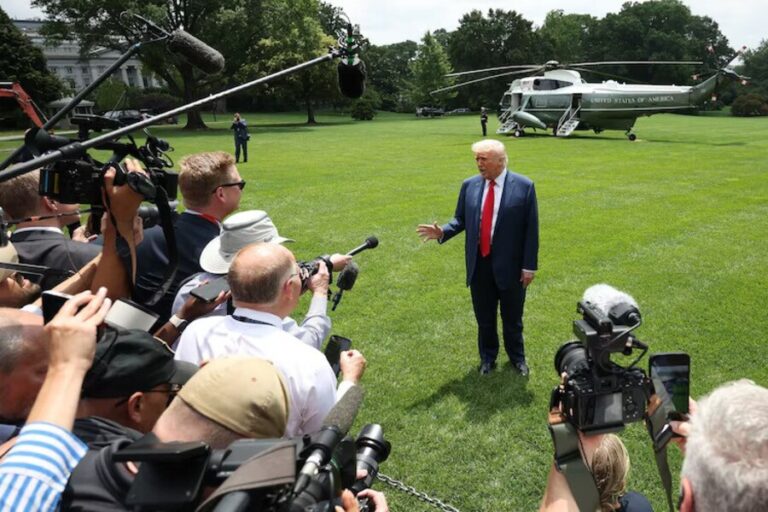In a move that could significantly reshape global trade dynamics, former President Donald Trump announced on his social media platform that the United States will impose sweeping 30% tariffs on imports from the European Union and Mexico, effective August 1. The decision has drawn immediate criticism from foreign leaders and raised concerns about escalating trade tensions.
Strong Action Against Mexico Over Fentanyl Trafficking
Trump cited continued cross-border fentanyl trafficking and insufficient efforts by Mexico to dismantle drug cartels as the primary reasons for targeting the southern neighbor. In a public letter addressed to newly elected Mexican President Claudia Sheinbaum, Trump acknowledged Mexico’s cooperation but stated that it fell short of expectations.
“Mexico has been helping me secure the border, BUT what Mexico has done is not enough. Mexico still has not stopped the Cartels, who are trying to turn all of North America into a Narco-Trafficking Playground,” Trump wrote.
Although Mexico was previously spared in Trump’s April 2 “Liberation Day” tariff rollout, which levied steep tariffs on steel, aluminum, and non-USMCA-compliant goods, this latest move imposes a broad-based 30% tariff on all Mexican imports.
The United States relies heavily on Mexican imports, particularly in the automotive, electronics, and agricultural sectors, including beer, produce, and spirits. Economists warn that tariffs on such vital imports may trigger inflationary pressures and disrupt supply chains in both nations.
Tariffs on the European Union: Trade Deficit the Main Target
In a separate letter to European Commission President Ursula von der Leyen, Trump justified the 30% tariff against the EU by citing the substantial U.S. goods trade deficit with the bloc, which hit $235.6 billion in 2024 — a 12.9% increase over 2023, according to the Office of the U.S. Trade Representative.
“We have tolerated this imbalance for far too long,” Trump stated in the letter, warning that previous tariff threats up to 50% were still on the table if future negotiations failed.
EU exports to the U.S. are heavily weighted toward high-value goods like pharmaceuticals, mechanical appliances, and industrial components. A 30% tariff on such products could severely disrupt transatlantic business operations, affect consumer prices, and hinder pharmaceutical availability.
Global Reaction: Pushback and Warning of Countermeasures
European Commission President Ursula von der Leyen issued a prompt response, warning that the proposed tariffs could have broad repercussions:
“The 30% tariff would hurt businesses, consumers, and patients on both sides of the Atlantic,” she said. “We will continue working towards an agreement by August 1. At the same time, we are ready to safeguard EU interests based on proportionate countermeasures.”
Meanwhile, Mexico’s Economic Minister Marcelo Ebrard also expressed strong opposition to the tariff plan, emphasizing that Mexico had been engaged in trade discussions with Washington in good faith.
“We were informed that, as part of the profound changes in U.S. trade policy, all countries will receive a letter signed by the President of the United States establishing new tariffs starting August 1st,” Ebrard said in a post on X. “We stated at the meeting that this was an unfair deal and that we did not agree with it.”
What This Means for U.S. Manufacturers and Consumers
Despite the sweeping nature of the tariffs, Trump reiterated that domestic manufacturers building or relocating operations within the U.S. would be exempt — a clear message aimed at incentivizing the reshoring of manufacturing jobs and facilities.
“There will be no tariffs on manufacturing companies that decide to build in the U.S.,” he wrote, echoing his long-standing ‘America First’ trade agenda.
While this may encourage some domestic investment, experts caution that U.S. consumers could bear the brunt of price hikes as importers pass on the cost of tariffs. Retailers and business groups are expected to lobby fiercely against the measures in the coming weeks.
What’s Next?
With less than three weeks until the tariffs take effect, the announcement leaves little time for meaningful negotiation. Both the EU and Mexico have signaled openness to continued dialogue but also a willingness to retaliate if their economies are harmed.
Analysts are closely watching how current and prospective trade allies — including Canada, China, and South Korea — respond to what many see as a sharp departure from traditional multilateral trade practices.
The Biden administration has yet to issue a formal response to Trump’s announcement, but political analysts suggest this could become a key flashpoint in the 2024 presidential race, particularly as economic policy takes center stage.
Takeaways for Readers:
- What happened? Trump announced 30% tariffs on imports from the EU and Mexico, starting August 1.
- Why does it matter? The tariffs could impact global trade, raise consumer prices, and provoke retaliatory measures from key allies.
- What’s next? Negotiations may continue until the deadline, but both the EU and Mexico have vowed to defend their economic interests.
Stay tuned as the story develops — further international reactions, domestic political ramifications, and economic forecasts are expected in the days ahead.
